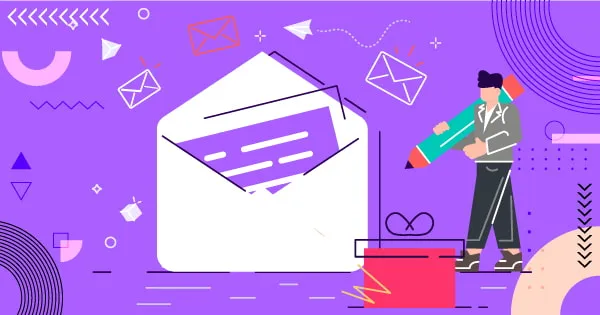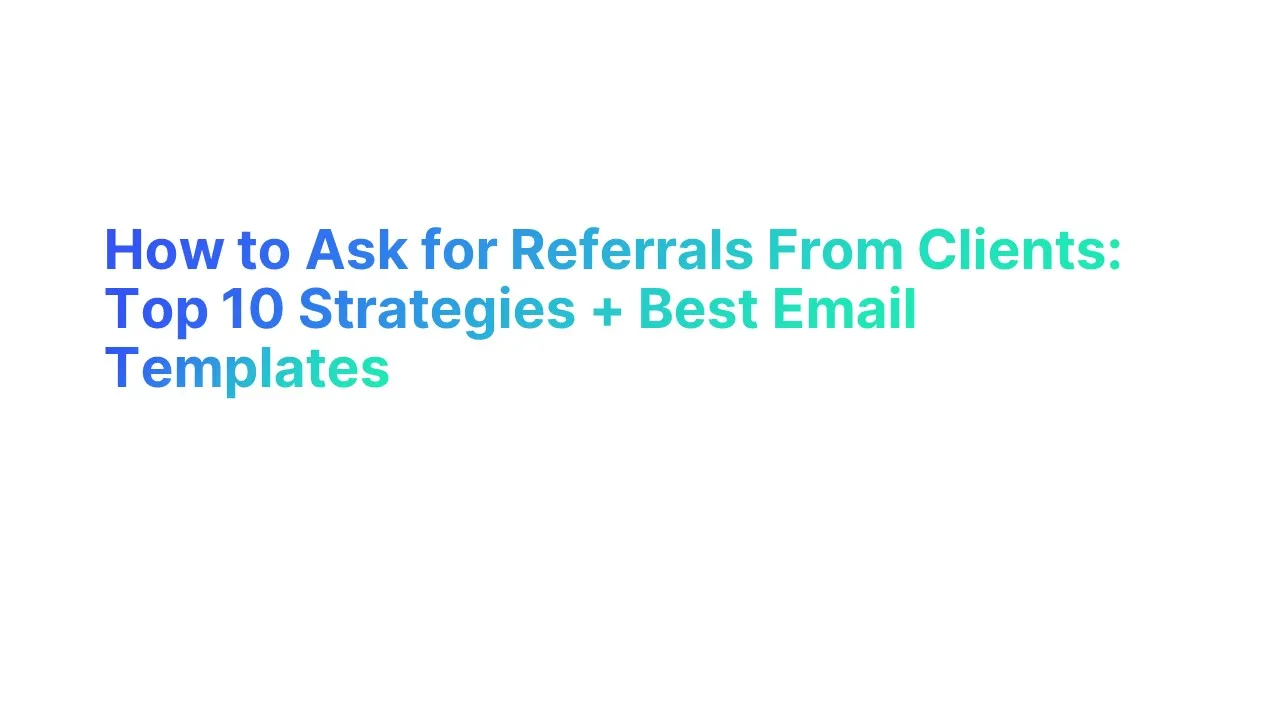Introduction to Referral Email

Referral emails from clients are communications where satisfied customers recommend your services or products to potential new customers through email. These emails are pivotal in leveraging the trust and satisfaction of existing customers to expand your client base organically.
Referral email from client helps in:
- High Trust Levels: Referral emails often boast high trust levels, with 92% of consumers trusting referrals from people they know
- Enhanced Conversion Rates: Referral leads convert 30% better than leads generated from other marketing channels
- Significant Revenue Impact: Businesses with formalized referral programs experience 86% more revenue growth compared to those without
Utilizing referral emails effectively can significantly amplify your marketing efforts, leading to increased customer engagement and revenue growth. Engaging existing clients to participate in your referral programs not only increase your client base but also reinforces client loyalty and satisfaction.
Why Companies Hesitate to Ask for Referrals

Many companies recognize the value of referrals but hesitate to actively seek them from clients. This hesitation often stems from several key concerns:
- Fear of Appearing Desperate: Some businesses worry that asking for referrals might make them seem desperate or pushy, potentially damaging the relationship they have built with their clients.
- Uncertainty About Timing: Determining the right moment to ask for a referral can be challenging. Companies often fear that asking too soon after a transaction might annoy the client, while waiting too long could result in missed opportunities for expanding their professional network.
- Lack of a Formal Process: Without a structured referral program, companies may feel unprepared or awkward about how to approach clients for referrals. This lack of a systematic approach can lead to inconsistency and reluctance in seeking referrals, affecting the entire referral process.
- Concerns Over Client Satisfaction: If there is any doubt about a client's satisfaction level, companies might hesitate to ask for a referral. They prefer to avoid the risk of exacerbating any potential dissatisfaction.
- Inadequate Training: Employees may not ask for referrals simply because they have not been trained on how to do so effectively. Without clear guidelines and communication skills training, employees might avoid these conversations altogether.
10 Ways to Ask for a Referral From Clients

Here are 10 ways to ask for a referral from clients, crafted based on your preferences and the understanding that building strong relationships and offering value are key:
1. Embed Referrals in the Follow-up
Integrating referral requests into your follow-up communications is a seamless way to make asking for referrals a routine part of your interaction with clients. This method avoids direct solicitation, making the request feel like a natural part of your customer service.
- Consistency is Key: Regular follow-up emails or calls after service delivery can include a soft ask for referrals, framed as an option for satisfied clients to share their positive experience.
- Success Rates: Companies that incorporate referral requests in follow-ups see a 35% higher conversion rate for referrals compared to those who ask sporadically.
- Example Template: Include a line like, "If you know anyone else who could benefit from our services, feel free to share their contact details, or direct them to our referral form linked below."
2. Provide Exceptional Service
Delivering beyond expectations creates a strong foundation for referrals. Satisfied clients are more likely to advocate for your services spontaneously.
- Client Satisfaction: Aim for high satisfaction rates; studies show that clients who rate services as "excellent" are over 50% more likely to refer others.
- Feedback Loop: Regularly gather and analyze customer feedback to ensure service quality remains high. Use positive feedback as a springboard for asking for referrals.
- Recognition and Rewards: Recognize and possibly reward clients for their referrals, enhancing their experience and encouraging continued advocacy.
3. Time Your Request Wisely
Choosing the optimal moment to ask for a referral can significantly impact the likelihood of receiving one. Timing your request when the client is most satisfied increases your chances of success.
- Critical Moments: After achieving a milestone or delivering a particularly successful outcome, approach the client for a referral. This taps into their immediate positive sentiments about your service.
- Data-Driven Timing: According to a study, asking for a referral three to five days after project completion results in a 20% higher success rate than asking immediately post-service.
- Follow Significant Improvements: If your service notably enhances the client's business or personal scenario, that's an ideal time to ask for a referral, linking the request to their recent success.
4. Use Indirect Approaches
Instead of directly asking for referrals, employing an indirect approach can ease the process and make clients more comfortable. This method involves suggesting rather than asking outright, which can be less intrusive and more effective.
- Suggestive Language: Use phrases like, “Feel free to mention us to anyone in your network who might need our services,” which encourages sharing without direct pressure.
- Success Stories: Share stories of how referrals have benefited other clients, subtly suggesting they might do the same. For example, mention, "Just last month, one of our clients referred a friend, and we were able to help them save 20% on their costs."
- Leverage Testimonials: Use client testimonials in your communications that mention the value of referrals, which can inspire other clients to consider referring as part of their engagement.
5. Educate Your Team
Your team's ability to ask for referrals reflects their training and understanding of its importance. Educating your team not only prepares them to handle referral requests effectively but also integrates the practice into your company culture.
- Regular Training: Conduct workshops and training sessions that teach how to ask for referrals tactfully and at the right time. Emphasize the role of customer satisfaction in making these asks.
- Role-playing Exercises: Implement role-playing scenarios that allow team members to practice asking for referrals in a low-pressure environment. This helps build confidence and skill.
- Monitor and Feedback: Keep track of referral requests and outcomes to provide constructive feedback and continuously improve techniques based on real data. Highlight successful examples as models for the team.
6. Create a Referral Program
Formalizing the referral process through a dedicated program can significantly increase your referrals. This provides a structured and clear path for clients to make referrals, often with incentives that motivate participation.
- Incentive Structure: Offer rewards for both the referrer and the referred, such as discounts, service upgrades, or even monetary rewards. For instance, offering a 10% discount on future services for each successful referral can motivate clients to participate actively.
- Clear Guidelines: Make sure your referral program has clear, simple rules that are easy for clients to understand and follow. Detail what qualifies as a successful referral and how the rewards are distributed.
- Promotion and Accessibility: Promote your referral program regularly through emails, social media, and during client interactions. Ensure that the information is easily accessible, such as through a dedicated section on your website or a digital brochure.
7. Ask for Feedback First
Initiating a conversation about referrals with a request for feedback can be a strategic move. It allows you to gauge client satisfaction and introduces the topic of referrals more organically if the feedback is positive.
- Implement Surveys: Use a customer satisfaction survey to understand client experiences and areas for improvement. Positive feedback can segue into a referral request.
- Feedback Channels: Offer various ways for clients to provide feedback, such as one-on-one calls, email surveys, or even quick polls on your website.
- Action on Feedback: Show clients that their feedback is valued by making visible improvements or acknowledging their suggestions. This builds trust and increases the likelihood of them making referrals.
8. Personalize Your Requests
Tailoring your referral requests to the individual client can significantly increase their effectiveness. Personalized interactions show that you value the client and understand their unique position in their network.
- Client-Specific Insights: Use what you know about the client's business or personal interests to personalize the referral request. For example, for a client who values community, suggest how their referral could help strengthen local business ecosystems.
- Direct Communication: Address clients by name and reference specific aspects of your service they enjoyed. This can make the referral request feel more genuine and less generic.
- Recognize Loyalty: For a loyal client, acknowledge their ongoing support before asking for a referral, which can reinforce their positive feelings towards your business.
9. Leverage Success Stories
Sharing success stories of other clients can be a powerful motivator. It demonstrates the tangible benefits of your services and the positive impact of referrals.
- Case Studies: Share detailed case studies or testimonials that highlight significant outcomes achieved through your services. Mention how these successes were often initiated through referrals.
- Client Spotlights: Feature stories of clients who have benefited from referrals in your newsletters or on your website, creating a narrative that others can see themselves participating in.
- Referral Impact: Emphasize how referrals have contributed to the growth of your business and helped clients meet others with similar needs through effective referral marketing.
10. Provide Easy-to-Use Referral Tools
Making the referral process as easy as possible encourages more clients to participate. Provide tools that simplify the act of referring, removing any potential friction.
- Digital Tools: Offer a simple online referral form or a dedicated landing page where clients can quickly submit the contact information of potential referrals.
- Referral Networking Group: Introduce clients to a referral networking group where they can exchange referrals with non-competing businesses, enhancing the value of their network.
- Templates and Scripts: Provide email templates or call scripts to clients, helping them make referrals without having to draft messages from scratch, which can be particularly useful for those unsure of how to start the conversation.
How to Write a Referral Email

Writing an effective referral email is crucial in leveraging your network to gain new opportunities or clients. A well-crafted referral email can make a strong impression, demonstrate professionalism, and increase the likelihood of a positive response. Here’s a detailed guide on how to compose an effective referral email:
1. Start with a Clear Subject Line
The subject line is your first chance to grab the recipient's attention. It should be direct and clear, indicating the purpose of your email. Use the recipient's name if possible, and mention the referral right away to set the context.
- Example: "Introduction Request – [Your Name] Referred by [Referrer’s Name]"
2. Personalize the Greeting
Address the recipient by name to personalize the email and establish a connection immediately. If you have met them before, a brief mention of the meeting can help jog their memory.
- Example: "Hello [Recipient’s Name], I hope this message finds you well. We met briefly at [Event/Location] last month, and I enjoyed our conversation on [Topic]."
3. Introduce Yourself
If the recipient doesn’t know you, a brief introduction is essential. Mention who you are, your current role or profession, and how you got their contact information (through a mutual contact, event, etc.).
- Example: "My name is [Your Name], and I am currently working as [Your Position] at [Your Company]. [Mutual Contact’s Name] kindly passed on your email details and thought it would be great for us to connect."
4. State the Purpose of Your Email
Be clear about why you are reaching out. If you’re asking for a job referral, for instance, specify the position you are interested in and why you think you would be a good fit.
- Example: "I am writing to seek your help. I learned about the [Job Title] opening at [Company Name] and am very interested in applying. Given your experience with [Company/Industry], I would appreciate any insights or a referral if you feel comfortable doing so."
5. Explain Why You’re Reaching Out to Them Specifically
Highlight your reasons for choosing this particular person for a referral. This could be their expertise, position, or your admiration for their work. This section should make the recipient feel valued and show that your request is thoughtful and well-researched.
- Example: "I have always admired your work in [Field/Industry] and the innovative approaches your team at [Company] is known for. Your insights would be incredibly valuable to me as I navigate this application process."
6. Add a Soft Call to Action
Encourage the recipient to respond or engage further without making them feel pressured. Offer options for how they might help, and make it as easy as possible for them to do so.
- Example: "If you are willing, I would greatly appreciate any advice or if you could introduce me to the hiring manager. I am also happy to provide more information or meet at a time that’s convenient for you to discuss this further."
7. Show Appreciation in Advance
Thank your recipient for considering your request. This not only shows good manners but also sets a positive tone for any future interactions.
- Example: "Thank you very much for considering my request. I truly appreciate any assistance you can provide and look forward to possibly working together in the future."
8. Include a Professional Sign-off
End your email with a professional closing that matches the tone of your email.
- Example: "Best regards, [Your Name]"
9. Proofread Before Sending
Always proofread your email for any grammatical errors or typos. A clean, error-free email reflects professionalism and attention to detail.
Referral Request Email Example
How to Spot Opportunities for Client Referrals

Identifying opportunities for client referrals is a key skill in business development and customer relationship management.
It involves recognizing the right moments and contexts in which to encourage satisfied clients to refer their friends, family, or business associates. Here’s how to effectively spot opportunities for client referrals:
1. After Positive Feedback
When a client expresses satisfaction with your service or product, it's a prime opportunity to ask for a referral. Positive feedback indicates that the client values your offering and is likely to recommend it to others.
Actionable Tip: Train your team to recognize positive feedback during interactions and follow up with a gentle suggestion about requesting referrals. For example, after receiving positive comments, they could say, "We’re thrilled you’re happy with our service! If you know anyone else who might benefit from what we do, we’d love to be introduced."
2. During Client Milestones
Celebrate milestones in your client’s journey with your company, whether it's an anniversary, a significant purchase, or the completion of a major project. These are moments of heightened engagement and satisfaction.
Actionable Tip: Send a congratulatory message or give a small gift and include a note about your referral program, explaining how they could share similar positive experiences with friends or colleagues.
3. When Clients Receive Extrinsic Rewards
If your business model includes rewards, discounts, or other value-added services, the moment when a client gains these benefits is a good time to ask for customer referrals. The positive experience associated with receiving a benefit can enhance their willingness to refer.
Actionable Tip: Attach a referral request to the communication about the reward. For instance, “Enjoy this discount on your next purchase! Know someone who could use our service? Refer them and earn rewards for each successful referral!”
4. After Resolving a Complaint or Problem
Turning a negative situation into a positive one can often lead to a loyal client who is more likely to refer others. If a client’s complaint is handled exceptionally well, they may feel compelled to share their positive resolution experience with others.
Actionable Tip: After ensuring the client is satisfied with the resolution, you might say, “We’re so glad we could resolve that for you. If you know anyone else who could benefit from our attentive service, we’d appreciate your referral.”
5. During Networking Events
Events that gather like-minded individuals or industry peers are excellent for spotting referral opportunities. Engage with clients in a less formal setting and introduce the idea of referrals.
Actionable Tip: Host or attend industry events and use the opportunity to discuss how referrals have positively impacted your clients, possibly encouraging them to consider whom they might refer.
6. When Introducing New Products or Services
Launching new offerings is a great time to reach out to existing clients. They may know others who could benefit from your latest products or services.
Actionable Tip: Announce your new product or service and mention that referrals are welcome. For instance, “We thought you might like to try our new [product/service]. Feel free to share this news with anyone you know who might be interested!”
7. Utilizing Social Media Interactions
Monitor social media for positive mentions from your clients. When a client posts about their positive experience, it’s an opportunity to engage with them and their network.
Actionable Tip: Respond to positive posts and privately message the client with thanks, perhaps nudging them about your referral program.
8. Client Surveys and Follow-Ups
Use surveys and follow-ups to gauge client satisfaction and identify potential referral sources. Clients who score high on satisfaction metrics like the Net Promoter Score (NPS) are likely candidates.
Actionable Tip: For clients with high NPS scores, follow up with a personal note and a referral request, explaining how much you value clients like them and their recommendations.
8 Customer Referral Templates
here are seven customer referral templates that you can use to effectively ask for referrals from your clients:
1. Happy Client Introduction Template
Template Benefit: This template leverages the client’s positive experience and satisfaction to encourage referrals, reinforcing their happy engagement with your business while offering an incentive for successful introductions.
2. Satisfied Customer Referral Request
Template Benefit: This template directly asks for a referral by tapping into the client's satisfaction, making it feel like a natural extension of their positive experience. It also clarifies the process, making it easy for clients to refer their contacts.
3. Client-to-Client Referral Invitation
Template Benefit: This email encourages clients to become active participants in your business's growth by joining a 'referral community.' It makes the process feel exclusive and rewarding, fostering a deeper client engagement and loyalty.
4. Peer Recommendation Request
Template Benefit: This email leverages the professional credibility of your client to gain referrals within their industry or peer group. By acknowledging their expertise and the mutual respect among peers, this template aims to generate referrals that are well-informed and highly valuable.
5. Success Story Sharing Invitation
Template Benefit: This template focuses on emotional engagement, using the client’s success story as a tool to inspire referrals. It not only boosts the client’s sense of importance and satisfaction but also uses their narrative to attract similar clients.
6. Client Appreciation & Referral Request
Template Benefit: This email combines appreciation with a referral request, making the client feel valued and part of your business's success story. The focus on gratitude helps deepen the client's emotional connection to your brand, potentially increasing their willingness to refer others.
7. Mutual Benefit Referral Proposal
Template Benefit: This email directly addresses the reciprocal nature of referrals, emphasizing the tangible benefits to both parties. It aims to create a sense of partnership with the client, encouraging them to engage in referral activities as a win-win scenario.
8. Client Network Expansion Offer
Template Benefit: This template focuses on the professional growth and networking benefits that come with referrals, appealing particularly to clients interested in expanding their own business or professional contacts. It positions the referral program as an exclusive opportunity, adding value beyond the immediate service.
9. Referral Email Template for Existing Customers
Template Benefit: This template is crafted to remind existing customers of their value to the business and to incentivize them to make referrals. It emphasizes ease and appreciation, making the client feel respected and valued for their efforts to help the business grow.
Concluding Thoughts for a Successful Referral Request
Successfully leveraging client referrals hinges on strategic, thoughtful engagement, driven by a well-prepared marketing team. By equipping your team with effective referral strategies and robust email templates, you can tap into the network of quite a few clients, expanding your reach significantly. Each client interaction offers a potential referral opportunity that can lead to substantial growth.
Tailor these approaches to fit your unique business context, continuously refine your tactics based on feedback, and ensure your marketing efforts resonate well with both current and prospective clients. A strong referral program not only broadens your client base but also bolsters loyalty and satisfaction, reinforcing your market presence.





.webp)


